Examining the Possibility of Using Solar Energy to Provide Warm Water Using Retscreen4 Software (Case Study: Nasr Primary School of Pirbalut)
Javad Riahi Zaniani1 * , Reza Heydarian Dehkordi1 , Amin Bibak1 , Parviz Bayat1 and Mehdi Jahangiri2
Corresponding author Email: javadriahi68@gmail.com
DOI: http://dx.doi.org/10.12944/CWE.10.Special-Issue1.101
This paper aimed to examine the possibility of supplying warm water for a 90-student-primary school using solar energy. The used solar water-heater belongs to Solar Polar Company. The RETScreen4 software was used for economic analysis and determining the time of capital return. Some different scenarios were used for analysis indicating the increase of the time of capital interest by reduction of the inflammation rate. In addition, if government pay for the 50% of expenditure, the capital return will be obtained 2.4 years sooner.
Copy the following to cite this article:
Zaniani J. R, Dehkordi R. H, Bibak A, Bayat P, Jahangiri M. Examining the Possibility of Using Solar Energy to Provide Warm Water Using Retscreen4 Software (Case Study: Nasr Primary School of Pirbalut). Special Issue of Curr World Environ 2015;10(Special Issue May 2015). DOI:http://dx.doi.org/10.12944/CWE.10.Special-Issue1.101
Copy the following to cite this URL:
Zaniani J. R, Dehkordi R. H, Bibak A, Bayat P, Jahangiri M. Examining the Possibility of Using Solar Energy to Provide Warm Water Using Retscreen4 Software (Case Study: Nasr Primary School of Pirbalut). Special Issue of Curr World Environ 2015;10(Special Issue May 2015). Available from: http://cwejournal.org?p=727/
Download article (pdf)
Citation Manager
Publish History
Select type of program for download
| Endnote EndNote format (Mac & Win) | |
| Reference Manager Ris format (Win only) | |
| Procite Ris format (Win only) | |
| Medlars Format | |
| RefWorks Format RefWorks format (Mac & Win) | |
| BibTex Format BibTex format (Mac & Win) |
Article Publishing History
| Received: | 2014-11-10 |
|---|---|
| Accepted: | 2014-11-29 |
Introduction
Optimizing the energy consumption is one the most central topics in literature of world energy and, nowadays, reduction of the fossil energies consumption has been regarded as an energy recourse. One of the most important ways of energy consumption is replacing the current technology by those systems which use renewable energies as energy resource instead of fossil fuels. The most widespread application of the renewable energies is their use for heat production relating to bio-fuels and solar water-heater generally. Accordingly, one of the most efficient kinds of technology related to renewable energies is the technology solar water-heater. The total installed capacity of the solar water-heaters all around the world until 2013 was reached to 365000 thermal Megawatt (TMW).
Diagram 1 shows that solar water-heaters have been regarded the same as windy plants all around the world. In addition, the installed capacity of these water-heaters based on thermal Gigawatt (TGW) is 2.5 fold of the capacity of all solar cells around the world based on electrical Gigawatt (EGW). The increasing procedure of the installed capacity of the solar water-heaters around the world in figure 2 reveals that the above technology has paved its way in heating systems. The statistics indicates that, like the developed countries, the developing economies are using the technology of solar water-heaters in order to stop the consumption of fossil fuels. China, the US, Germany, Turkey, India and Japan are the pioneers of using this kind of water-heater. The diagram of average of the annual sunshine is presented in figure 3 indicating that this average in Iran has been more than the global average and, as a result, using the solar energy capacity is prior to other kinds of renewable energies.
Materials and Methods
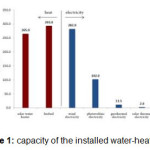 |
|
![Figure 2: total capacity of the installed solar water-heaters with vacuum tube and glassy flat around the world [2]](http://www.cwejournal.org/wp-content/uploads/2015/05/Vol10_Spe_Exam_Java_Fig2-150x150.jpg) |
|
![Figure 3: diagram of the average of annual sunshine around the world [3]](http://www.cwejournal.org/wp-content/uploads/2015/05/Vol10_Spe_Exam_Java_Fig3-150x150.jpg) |
|
![Figure 4: diagram of the average of annual sunshine in Iran [3]](http://www.cwejournal.org/wp-content/uploads/2015/05/Vol10_Spe_Exam_Java_Fig4-150x150.jpg) |
|
Iran experiences more than 300 sunny days annually. To understand the necessary of paying attention to developing this technology in Iran, it is enough to know that, although the average of annual sunshine in Germany is half of Iran’s, the capacity of its active water-heaters is 100 fold of Iran.
The table below shows the relative average rate of annual sunshine in different countries along with the amount of the installed capacity of water-heaters according to the predicting of statistics of 2012.
Table 1: average of the annual sunshine in Iran and pioneer countries in technology of the solar water-heaters and total of the installed capacity in each country based on predicting the statistics at the end of 2012 [1, 2 and 4]
|
Country |
Average of annual sunshine Kwh/ |
Capacity of the installed water-heaters GW |
|
China |
1500 |
172 |
|
The US |
1600 |
19 |
|
Germany |
1000 |
12 |
|
Turkey |
1400 |
11 |
|
Brazil |
1900 |
5 |
|
Iran |
2000 |
0.1 |
According to accessibility of the solar water-heaters technology and their economical use in Iran, it is necessary for policy makers of the energy field and economic activists to pay a specific attention to this technology. Using this technology, we hope to reduce the waste of fossil fuels for providing hot water.
This paper attempted to replace the fossil energy for providing the hot water of a school by a solar water-heater. The calculations of consumptions and expenditures were analyzed by RETScreen4 software and, finally, the economic analysis and capital return were discussed.
Introducing the RET Screen4 Software
It is powerful software developed by government and some industrial centers and Clean Energy Project of Canada and used by researchers freely. It uses valid resources for analysis and has a powerful database. Every year, hundreds of project is analyzed by this software.
Results
The place of installing this system is primary school in Pirblout village is Shahrekord township located in southwest of Iran, Chaharmahal va bakhtiari province. The proportion of receiving solar energy in this area in different months is shown in table below. This table data is collected from the climate database of RETScreen4 extracted from NASA.
Table 2: The proportion of receiving solar energy in Shahrekord Township in different months
|
Daily solar ray (kwh/m2.d) |
Different months |
|
2.65 |
January |
|
3.48 |
February |
|
4.30 |
March |
|
5.45 |
April |
|
6.74 |
May |
|
7.71 |
June |
|
7.34 |
July |
|
6.82 |
August |
|
5.99 |
September |
|
4.54 |
October |
|
3.21 |
November |
|
2.42 |
December |
|
5.06 |
Average |
Shahrekord Township is located in 32.30 of northern and 50.90 of eastern latitude and longitude and its altitude from sea level is 2430 m.
According to the software data, the minimum and maximum temperature of the school inlet water are 9.40 and 18.40 respectively. It shows these data by estimating the area’s geographical condition.
Area of Pirblout Nasr primary school is 500 m2 whose 90% needs hot water. It has 90 students. Its daily required hot water is calculated 150 liter based on its water and gas bills. The outlet water temperature, according to the standards of educational spaces of Chaharmahal va Bakhtiari province, is 600.
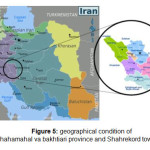 |
|
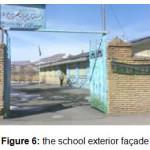 |
|
According to the education ministry law, the schools are open 5 days a week and 9 months a year, and considering the holidays in Iran, this school activeness percent was entered the software for each year separately.
Table 3: percent of the school activeness in different moths of a year
|
Usage percent |
Month |
|
100% |
January |
|
100% |
February |
|
100% |
March |
|
50% |
April |
|
100% |
May |
|
100% |
June |
|
10% |
July |
|
10% |
August |
|
30% |
September |
|
100% |
October |
|
100% |
November |
|
100% |
December |
According to the models of collector in Iran and the climate of Pirblout village, the model of Solar polar- t200 selective was selected. Because its weather is cold, 4 collectors were selected cost 53720000 rials (15500).
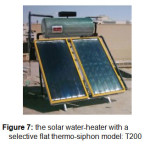 |
Figure 7: the solar water-heater with a selective flat thermo-siphon model: T200 Click here to View figure |
The thermo-siphon solar water-heater weighs 32 kg and has 3 parts costing $ 720 a) 2 selective flat collectors with level of 1.8 m2 and an aluminum frame for protection having a thermal insulation of rock wool with a 50 mm thickness and a solar glass with a 4 mm thickness and the passing coefficient to 90%, b) a two-wall tank whose metal model is 37ST and glaze coating and thickness of 2.5 mm and pressure tolerance up to 8 Barr with a real volume of 200 liters to provide hot water for 4 or 5 persons and c) installations and fittings with a 2 year-old guarantee of the Solar Polar Company .
These collectors were located in a fix way with the slope of 32.20 which is equal to the latitude. According to the amount of consumed water and the company, two 200-liter tanks were used for these collector. In general, the fossil fuel used for this school is natural gas which is now about 85% and, using solar water-heater, it is going to be decrease to 20%. The real fee of the consumed gas is 45 cents.
These data were entered RETScreen4 and analyzed. Its outlet was the diagram of capital return. The inflation rate and the project useful life were considered 25% and 20 years respectively. The expenditures included a two-cover tank with volume of 1000 liters costing $ 150 and cost of installing the water-heater about $ 42. According to the software analysis, the time of capital return is 7.8 years.
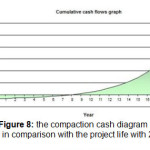 |
|
If the inflation rate decreased to 15%, the results will show the increase of time of the capital return and 10.1 years. If the inflation rate increased to 35%, the results will show reduce of the time of capital return and 6.5 years.
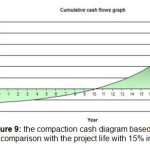 |
|
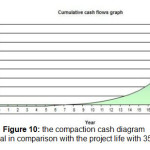 |
|
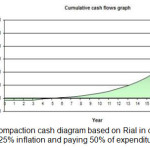 |
|
Discussion
Iran is located between the 250 and 400 of north latitude and. In terms of receiving solar energy among the different spots around the world, it is in high rank. The rate of sunlight in Iran is estimated between 1800 and 2200 kw/h m2 which is higher than the global average rate. In Iran more than 280 sunny days per year have been reported. One of the main consumers of fossil energies is schools. According to the Iran’s potential in terms of receiving solar energy, it is better to provide the schools’ needed energy for heating water by this energy. This paper studied the use of solar water-heaters in a school in Chaharmahal va Bakhtiari economically using RETScreen4 and calculated the capital return of 7.8 and reduction of fossil fuel of 65%.
References
- Report of the international agency of energy on solar heat worldwide, edition of 2013.
- Report on global conditions of renewable energies in 2013, policy making network of renewable energies for 21 century (REN21).
- WWW.solargis
- Report on conditions of using solar energy in Iran and other countries, organization of fuel consumption optimization, April 2012.
- www.damatajhiz.com
- Clean energy project analysis: Retscreen engineering & cases textbook, “solar water heating project analysis chapter”, Minister of Natural Resources Canada 2001-2004.
- http://bus.tehran.ir, 2015-01-16
- http://lorestan.niopdc.ir, 2015-01-16
- Rehman, S., “Prospects of wind farm development in Saudi Arabia”, Renewable Energy, 30, 2005, pp. 447–463.
- Houri, A., “Solar water heating in Lebanon: Current status and future prospects”, Renewable Energy, 31, 2006, pp. 663–675.
- Gastli, A., Charabi, Y., “Solar water heating initiative in Oman energy saving and carbon credits”, Renewable and Sustainable Energy Reviews, 15, 2011, pp. 1851–1856.
- Tristan, C.A., Pena, D.G., Mediavilla, M.D., Amigo, M.R., Calderon, T.G., “Small hydropower plants in Spain: A case study”, Renewable and Sustainable Energy Reviews, 15, 2011, pp. 2729– 2735.
- Stevanovic, S., Pucar, M., “Financial measures Serbia should offer for solar water heating systems”, Energy and Buildings, 54, 2012, pp. 519–526.
- http://fa.wikipedia.org/wiki, 2015/16/01
- www.chaharmahalmet.ir.






